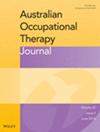The Rural Hand Therapy Project: A mixed methods study in a regional health service
Abstract
Introduction
Rural occupations carry a high risk of hand injury. In rural locations, provision of hand injury rehabilitation often falls to generalist occupational therapists. However, these therapists' capacity to provide hand injury assessment and treatment is limited. The Rural Hand Therapy Project (RHTP) was developed to improve access to hand therapy for patients living in rural areas by supporting rural generalist occupational therapists to provide hand therapy. The aim of this study was to investigate the impact, acceptability and experience of the RHTP for patients and clinicians.
Methods
A convergent mixed methods design was used. Adult outpatients with a hand injury, referred by a regional hospital orthopaedic department, were reviewed pre-intervention and post-intervention via patient questionnaires and chart audits. The intervention was the method of hand therapy provision measured as the standard model of care (regional specialised service) and alternate model of care (RHTP). The outcome measures recorded patients' perspectives of treatment efficacy using the DASH, PSQ-18 and the SF-36. Semistructured interviews were conducted to evaluate the clinicians' experience of the RHTP.
Consumer and Community Involvement
No consumers were involved in the study conceptualisation or analysis.
Results
Sixty-seven people were eligible and 52 people completed the study. Data were available for 33 patients treated via the standard model of care and for 19 patients treated via the RHTP. No significant difference was found between the two groups with regard to patient satisfaction, level of improvement and fidelity of service. The qualitative data obtained from interviews with eight clinicians revealed four major themes: a rural generalist that provides specialist care; increasing rural demand; flexible and proactive care; and ‘if we stopped it now, we would go backward’.
Conclusion
This study demonstrated that the RHTP provided similar outcomes for hand therapy care for rural and remote patients when compared to their regional counterparts. Consideration of context and potential unintended impacts are important in implementation.
PLAIN LANGUAGE SUMMARY
Hand injury treatment can be hard to access in rural areas compared to less rural areas. The Rural Hand Therapy Project was started to improve access to hand therapy treatment for people from rural areas. The program uses a few methods. These include: a regional therapist can see complex patients for their first session; better written and verbal reports about patient care; increased access for rural staff to training and advice from regional staff. The aim of the study was to look at what patients and staff from rural areas thought of the program and if the program achieved improvements. Fifty-two people were part of this study. We measured if people living in rural areas, whose care was helped by the program, were as happy with their care as people living in a regional area. We also measured if these rural people made the same gains as those living in a regional area. We also talked to the rural staff to know what they thought of the program. The study showed that the patients from a rural area were as happy with their treatment as the regional hospital patients. Both groups got the same level of care and made the same amount of gains. Rural staff thought the program was useful. The study also showed some findings about the increased cost to rural sites to deliver hand therapy and the challenge of deciding which people should be treated first.

 求助内容:
求助内容: 应助结果提醒方式:
应助结果提醒方式:


